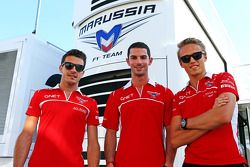How would three-car teams affect the F1 driver market?
The talk surrounding three car teams returning to F1 has been escalating.

Photo by: McLaren Mercedes



















The Monza paddock is always abuzz with rumours and speculation whenever Formula One comes to town, and this year was certainly no exception.
Perhaps the most shocking revelation of all came in the form of a tweet posted by former Williams CEO Adam Parr not long after Lewis Hamilton took the chequered flag last Sunday, saying: “This is the last year of F1 as we know it. In 2015 eight teams will contest the championship, with several teams entering three cars.”
Predictably, Parr’s tweet has generated intense discussion regarding the pros and cons of allowing those teams with sufficient resources to enter a third car, an idea long favoured by F1 tsar Bernie Ecclestone as well as recently departed Ferrari president Luca Di Montezemelo.
But, instead of weighing into this already-crowded debate, this article seeks to examine the implications for the driver market were third cars to be permitted in 2015.
How it would all shake out
These predictions rest on a number of assumptions – principally, that, as has been recently speculated, both Caterham and Marussia will not make it next season due to a shortage of cash, and that only the four biggest teams (Mercedes, Red Bull, Ferrari and McLaren) will choose to run third cars, thus keeping grid sizes at their current level of 22.
It is also assumed that there will be no major shock driver market moves among the sport’s leading protagonists – although question marks still hover over the future plans of Sebastian Vettel and Fernando Alonso in particular.
So, bearing that in mind, let’s take a look at how the grid could shape up in 2015:
Mercedes – Lewis Hamilton/Nico Rosberg/Nico Hulkenberg
With the Silver Arrows’ pair of current drivers unlikely to jump ship unless this year’s title battle takes a particularly bitter turn, the introduction of third cars would leave just one slot to fill at Brackley. And, as the brewing rivalry between Hamilton and Rosberg is already proving tricky to manage, the Mercedes top brass are unlikely to want another alpha male to complicate matters further.
The ideal candidate would thus be Nico Hulkenberg, who could be relied upon to score strongly, push Hamilton and Rosberg hard, but also to do so unobtrusively and without further disturbing team harmony. The nationality card is also in the German’s favour, as well as his existing links with Mercedes via his current team Force India.
Red Bull – Sebastian Vettel/Daniel Ricciardo/Jean-Eric Vergne
It seemed that the F1 career of Jean-Eric Vergne was effectively over following the announcement that Max Verstappen would be taking the Frenchman’s berth at Toro Rosso next season. But, the introduction of third cars could hand him a reprieve as ‘JEV’ would arguably be the logical option to line up alongside Vettel (assuming he’s not lured away by McLaren) and Ricciardo.
While Daniil Kvyat is probably the better long-term option, there would be no harm in allowing the 20-year-old Russian at least one more season to develop at Toro Rosso before potentially stepping up to the senior team in 2016 in place of Vettel – should he depart – or Vergne if not.
Ferrari – Fernando Alonso/Kimi Raikkonen/Jules Bianchi
The Scuderia has recently re-iterated its desire to maintain its existing line-up for next year, and with Alonso looking unlikely to take the gamble on a move to McLaren in 2015 and Raikkonen experiencing a modest upturn in form lately, there’s likely to be only one vacancy at Maranello for next year – and only one real candidate to fill it.
Jules Bianchi, a member of Ferrari’s junior scheme since 2009, has been one of the most impressive young drivers of the season, and not just because of his result at Monaco. Placing the Frenchman in a third car would eliminate the risk associated with making him one of only two drivers, giving him not one but two accomplished former champions from whom to learn in his first year at the famed Italian squad.
McLaren – Jenson Button/Kevin Magnussen/Romain Grosjean
There’s been plenty of speculation surrounding McLaren’s thinly veiled attempts to lure either Vettel or Alonso to Woking for the start of the team’s Honda-powered era next year. Nonetheless, should such efforts falter, there would be several candidates to slot into a third cockpit alongside incumbents Jenson Button and Kevin Magnussen.
One would be GP2 ace Stoffel Vandoorne, the next driver in line for a promotion to F1 in McLaren’s junior scheme – but running two relatively inexperienced drivers would be risky. A better option would be Romain Grosjean, who blossomed at Lotus last year under the watchful eye of Eric Boullier and would offer a happy medium between the experience of Button and youth and raw speed of Magnussen.
The two-car teams
We already know exactly who will be driving for Williams (Valtteri Bottas/Felipe Massa) and Toro Rosso (Daniil Kvyat/Max Verstappen) next season, which leaves just Force India, Lotus and Sauber.
Hulkenberg heading to Mercedes would leave a slot open at Force India alongside Sergio Perez, who seems likely to stay on. This could easily be filled by current third driver Dani Juncadella, who has recently been linked to a drive with the team regardless by Motorsport.com, or perhaps McLaren protégé Vandoorne.
Lotus meanwhile would need a driver to replace Grosjean, and with the Enstone-based team’s finances still in a parlous state, the Franco-Swiss’ replacement would need to bring funding. Formula Renault 3.5 driver Jazeman Jaafar, who enjoys the backing of oil giant Petronas, has been linked to the drive, but this would depend on Lotus completing its deal to run with Mercedes engines next year.
Other drivers with sufficient cash to take up a Lotus berth should the Petronas deal fail to materialise include Caterham’s Marcus Ericsson and Sauber’s Esteban Gutierrez. If the Mexican was to move to Enstone, Sauber has a raft of in-house replacements upon which to call.
The safest option of these is ex-Caterham pilot Giedo van der Garde, who is already reported to have signed a deal to replace Adrian Sutil in 2015. Alternatives include Formula Renault 3.5 driver Sergey Sirotkin, set to make his F1 free practice debut at his home race in Sochi, and the potentially lucrative Swiss lady racer Simona de Silvestro.
Of course, all of these predictions are largely based upon conjecture, and there’s still no guarantee that both Lotus and Sauber will be around next year either if recent paddock hearsay is to be believed.
But, what is clear is that, if Parr’s prediction of three-car teams does come to fruition, it will have an impact on the driver market that has the potential to make or break a number of careers.
Be part of Motorsport community
Join the conversationShare Or Save This Story
Subscribe and access Motorsport.com with your ad-blocker.
From Formula 1 to MotoGP we report straight from the paddock because we love our sport, just like you. In order to keep delivering our expert journalism, our website uses advertising. Still, we want to give you the opportunity to enjoy an ad-free and tracker-free website and to continue using your adblocker.























Top Comments